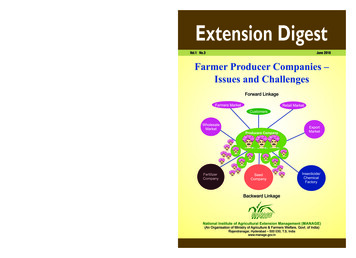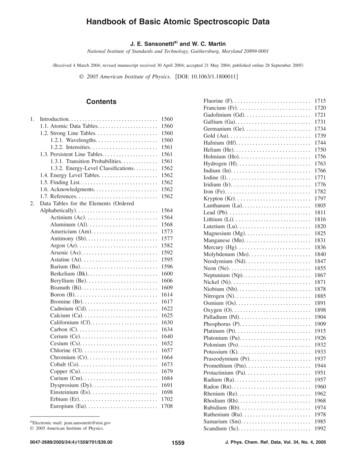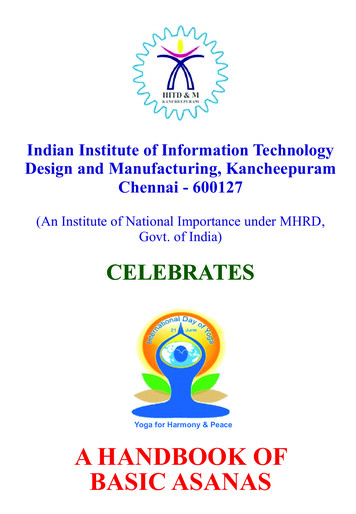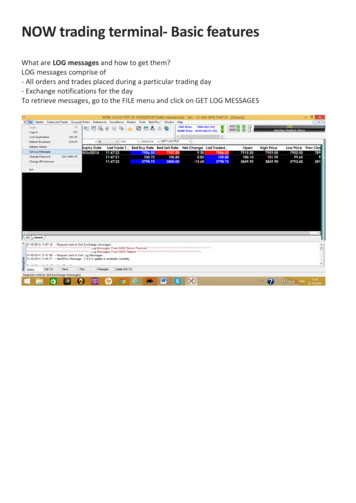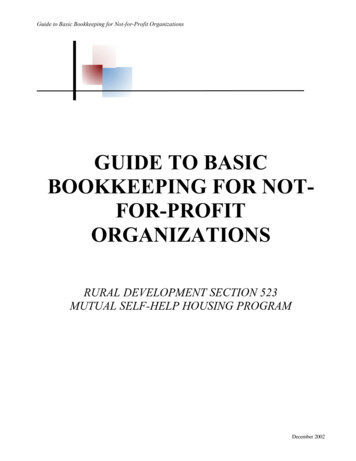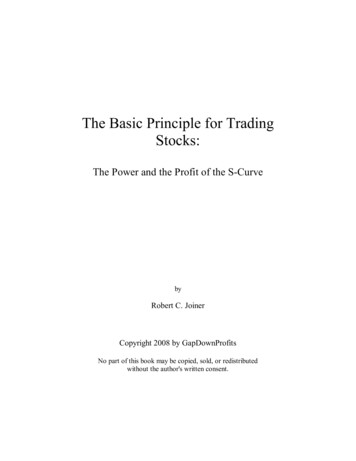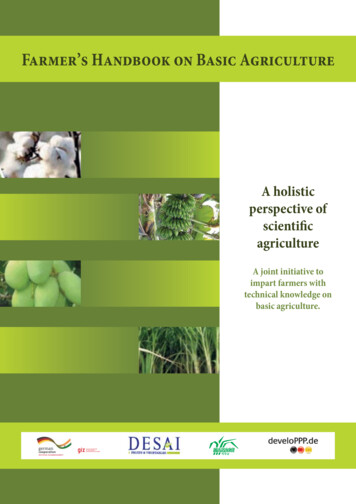
Transcription
Farmer’s Handbook on Basic AgricultureA holisticperspective ofscientificagricultureA joint initiative toimpart farmers withtechnical knowledge onbasic agriculture.
Disclaimer:The opinions expressed provided in this publication are those of the authors and do not necessarily reflect those of GIZ . Thedesignations employed and the presentation of material in this publication do not imply the expression of any opinion whatsoever on the part of GIZ concerning the legal status of any country, territory, city or area, or concerning the delimitation ofits frontiers or boundaries.
Farmer’s Handbook on Basic AgriculturePrepared & compiled byDr. P. Chandra ShekaraNational Institute of Agricultural ExtensionManagement (MANAGE)Ministry of Agriculture, GoIHyderabad, Andhra PradeshIndiaDr. N. BalasubramaniNational Institute of Agricultural ExtensionManagement (MANAGE)Ministry of Agriculture, GoIHyderabad, Andhra PradeshIndiaDr. Rajeev SharmaDr. Chitra ShuklaDesai Fruits & Vegetables Pvt. Ltd.Navsari, GujaratIndiaDr. Ajit KumarDesai Fruits & Vegetables Pvt. Ltd.Navsari, GujaratIndiaBakul C. ChaudharyDesai Fruits & Vegetables Pvt. Ltd.Navsari, GujaratIndiaMr. Max BaumannPlanning OfficerSection “Agricultural Production & Resource Use”Division 45 - Rural Development and AgricultureDeutsche Gesellschaft für Internationale Zusammenarbeit (GIZ) GmbHGermanyMax.Baumann@giz.deFinanced byDesai Fruits & Vegetables Pvt. Ltd.Navsari, Gujarat, IndiaGerman Federal Ministry for Economic Cooperationand Development (BMZ)Published byDesai Fruits & Vegetables Pvt. Ltd.Navsari, GujaratIndiaSecond Edition: August 2016Farmer’s Handbook on Basic Agriculture
The Authors acknowledge the contribution of following experts/professionals in developing theHandbook.Mr. Max Baumann, Planning Officer, GIZ, GermanyMr. Fredrick Oberthur, Planning Officer, GIZ, GermanyMr. Ajit Kumar Desai, Chairman, DFV, Navsari, GujaratDr. Sashidhar, Professor, University of Agriculture and Horticultural Sciences, Shimoga, KarnatakaDr. Syed Ahmed Hussain, Professor, ANGRAU, Hyderabad, TelanganaMr. V.Gunasekaran,Agricultural Officer, Pesticide Testing Laboratory, Dharmapuri, TamilnaduDr. M.V.Shantharam, Former Dean, ANGRAU, Hyderabad, TelanganaDr. K. Kareemulla, Principal Scientist, NAARM, Hyderabad, TelanganaDr. K.V. Jayaraghavendra Rao, Principal Scientist, NAARM, Hyderabad, TelanganaMr. Thomas A Vivian, Assistant Professor, College of Agriculture, Dhule, MaharastraProf. T. M. Bahale, Professor of Agronomy, College of Agriculture, Dhule, MaharastraDr. R. K Rahane, Professor of Agricultural Economics, College of Agriculture, Dhule, MaharastraDr. G. D. Patil, Professor of Soil Science & Agricultural Chemistry, College of Agriculture, Dhule, MaharastraDr. D. N. Padule, Professor of Plant Pathology, College of Agriculture, Dhule, MaharastraDr. A. R. Pathak, Vice Chancellor, Navsari Agricultural University, Navsari, GujaratDr. J. B. Patel, Professor, Anand Agricultural University, Anand, GujaratDr. Bhaskar Gaikwad, Programme, Coordinator, KVK, Babhaleshwar, MaharashtraMr. Mahendra Dhaibar, CEO, Sustainable Agricultural Development Foundation, Pune, MaharashtraDr. R. M. Pankhaniya, Associate Professor, Department of Agronomy, NM College of Agriculture,Navsari Agricultural University, Navsari, GujaratDr A. M. Bafna, Principal & Dean, Aspee Agri-Business Management Institute, Navsari AgriculturalUniversity, Navsari, GujaratDr G. G. Radadia, Professor & Head, Department of Entomology, NM College of Agriculture, NavsariAgricultural University, Navsari, GujaratDr B. P. Mehta, Professor, Department of Plant Pathology, Aspee College of Horticulture and Forestry,Navsari Agricultural University, Navsari, GujaratDr. L. J. Desai, Associate Professor, Department of Agronomy, NM College of AgricultureNavsari Agricultural University, Navsari, GujaratDr. N. S. Manohar, Associate Professor, Department of Agricultural Economics, Aspee College ofHorticulture and Forestry, Navsari Agricultural University, Navsari, GujaratDr O P Sharma, Associate Professor & Head, Department of Extension Education, College of VeterinaryScience & AH, Navsari Agricultural University, Navsari, GujaratDr. Bruno Schuler, Advisor and Planning Officer, Sustainable Agriculture-Rural Development, GIZ,GermanyMr. Rajiv Ahuja, Technical Expert, Natural Resource Management, GIZ, IndiaMr. Akhil Dev, Junior Technical Expert, Natural Resource Management, GIZ, India
AcknowledgementHigher demand for agricultural raw material is now anticipated and agriculture is not any more aboutproducing farm products and selling them exclusively at the local market. Instead farmers today havea world market to serve. But the new chances bring new challenges. Farmers and agricultural enterprises,willing to be part of the new expanding world market, not only have to take into consideration customers’preferences whom they want to serve, but also adhere to international trade regulations set by WTO andcomply with high production and quality standards required by the importing countries.Agriculture contributes around 17% to GDP and continues to be among the most important and successful sectors in India. Around 58% of the Indian population depend on agriculture for their livelihood. Apartfrom delivering the local industries with top quality raw materials for processing, agriculture providesalmost 10% of total export earnings. However, to support the impressive Indian economic growth in thecoming years, agriculture will have to contribute more towards value addition, productivity enhancement,high quality products and trained manpower to successfully tackle these challenges.The states of Gujarat and Maharashtra have competitive advantages for the production of several commodities. However, productivity and competitiveness remains low. Rising quality requirements of exportand domestic markets require an up-scaling of the production which is only feasible with educated farmersand skilled workers.Desai Fruits and Vegetables (DFV)in cooperation with the Deutsche Gesellschaft für InternationaleZusammenarbeit(GIZ) GmbH on behalf of the German Federal Ministry for Economic Cooperation andDevelopment (BMZ) takes up the existing education gap by implementing a development partnershipcalled “Partnership Farming India”.The goal of Partnership Farming India (PFI) is to enable farmers to be self-sufficient decision-makers,“agripreneurs”, which allows for a more flexible production system and highlights farming as profession bychoice and not by inheritance.Furthermore, PFI strengthens farmers’ and farm workers’ management skills to adopt modern agricultural practices and concepts and enhance the international competitiveness of smallholders’ agriculturalproduce by giving farmers and workers in Gujarat and Maharashtra access to practical agricultural education. Therefore, DFV and GIZ in close cooperation with the National Institute of Agricultural ExtensionManagement (MANAGE, an organization of Ministry of Agriculture, Government of India) developed thetraining material on basic agricultural knowledge and skills.The states of Gujarat and Maharashtra will serve as an example on how to establish long term successfuland trustful business relationships by combining small scale production in the field with large scale processing and marketing. I am confident that this effort will serve the Indian agriculture as a replicable modelmake lasting contributions towards sustainable agriculture and prosperous farmers.I would like to express my sincere gratitude to the people and institutions namely MANAGE, DFV andGIZ,which supported this project and enabled making information available. This is a useful source of information for farmers, trainers, and other interested persons to improve not only the agriculture but alsothe livelihood of the farming community.Mrs. Sabine PreussGIZ-India Programme DirectorNatural Resource ManagementFarmer’s Handbook on Basic Agriculture
PrefaceAgriculture is an important sector of Indian Economy as more than half of its population relies on Agriculture as principle source of income. Research and Extension systems play major role in generationand dissemination of Agricultural technologies aiming at enhancing the income of farmers. The extensionsystem adopts series of extension methods such as Training, demonstration, exposure visit to transferthe technologies from lab to land. Majority of these extension efforts mainly focus on location and cropspecific technologies, and mostly on solution to problem basis. However, there is a need for equipping thefarmers with Basic knowledge of Agriculture in order to create a better knowledge platform at farmer levelfor taking appropriate farm management decisions and to absorb modern technologies.In view of this, Desai Fruits and Vegetables Pvt. Ltd. (DFV), India, in cooperation with the DeutscheGesellschaft für Internationale Zusammenarbeit (GIZ) GmbH on behalf of the German Federal Ministryfor Economic Cooperation and Development (BMZ) in close cooperation with National Institute of Agricultural Extension Management (MANAGE- An Organization of Ministry of Agriculture, Governmentof India) brought out Farmer’s Handbook on Basic Agriculture to impart technical knowledge on BasicAgriculture to farmers to provide holistic perspective of scientific Agriculture.This handbook is a product of series of brainstorming workshops and consultative meetings with variousstakeholders such as Researchers, Academicians, Extension Functionaries, Agripreneurs, Master Trainersand Farmers. Based on the identified needs, the topics were prioritized and contents were developed withthe help of experts. The farmer-friendly content has been written in simple language, using more pictureswith practical examples for the benefit of farmers.The book contains six chapters, each focusing on a particular topic. The first chapter, “General conditionsfor cultivation of crops”, talks about the basic needs of farmers and farming sector, by providing basicknowledge on Good Agricultural Practices (GAP), enhancing the awareness of farmers on critical factorsin selection of crops and cropping patterns, judicious use of natural resources such as soil and water, andemphasizing the importance of mechanization in the field of agriculture.The second chapter “Soil and Plant Nutrition” is aimed at increasing the awareness and understanding offarmers about soil, it’s structure, physical, chemical, biological properties, soil fertility and managing thesoil fertility in an economically and environmentally sustainable manner. It also focuses on the need forsoil testing, plant nutrition requirement, organic & inorganic fertilizers, and Integrated Nutrient Management (INM) for efficient, economic and sustainable production of crops.The third chapter of the book is about Pest Management, and focuses on enhancing the awareness of andunderstanding among farmers about the crop pests, diseases and weed management through IntegratedPest Management. It also aims at sensitizing farmers on safe handling of chemicals and plant protectionequipments as also elaborated further in the fifth chapter on “Occupational health and safety of farmers”.It creates awareness about causes, preventive measures of health hazards, risks & fatalities in agriculture,and use of first aid in emergencies. It further includes safety tips and care to reduce the risk of injuries andfatalities while handling machineries and pesticides by farmers.Time and resources management is an integral part of each and every activity, be it service sector, business or day-to-day activities of life. Farming sector too has not remained untouched by it. Therefore, thefourth chapter of the book is devoted to “Farm Management”. It is to educate and equip the farmers tomake proper plans, take appropriate decisions and also to take advantage of the improved technologiesto increase production, assure food security for the family and market opportunities to increase incomeconsidering available resources, anticipated risks, including market fluctuations.“Farmer’s access to services”, the last chapter of the book, aims at enhancing awareness among farmersabout sources of extension, information and services, public and private extension services, agriculturalcredit, insurance and legal aspects through Information & Communication Technologies. The content isuseful not only for farmers but also for other stakeholders involved in farm advisory services such as Agriinput dealers, Agripreneurs, Kisan Call Centers and extension functionaries working at grass roots level.We trust that this Handbook will benefit maximum number of farmers to make farming economically andenvironmentally more sustainable.B. Srinivas, IASDirector GeneralMANAGEFarmer’s Handbook on Basic Agriculture
Contents1.General Conditions for Cultivation of Crops1-322.Soil and Plant Nutrition 33-703.Plant Protection71-964.Categories of Pesticides and Precautions97-985.Farm Management99-1206.Occupational Health and Safety121-1307.Farmer’s Access to Service131-136Farmer’s Handbook on Basic Agriculture
General Conditions for Cultivation of Crops1. General Conditions for Cultivation of Crops1.1. Objectives of the session To enhance awareness of farmers on critical factors in selection of crops and cropping patterns.To create an understanding on judicious use of natural resources such as soil and water.To provide basic knowledge on seed and cropping systems.To emphasize the importance of mechanization.To sensitize the farmers on Good Agricultural Practices (GAP).1.2. What do we know at the end of the session ACritical factors in selection of crops and cropping patternsJudicious use of natural resources such as soil and waterBasic knowledge on seedCropping systemsMechanizationGood Agricultural Practices (GAP)gricultural Universities, Research Institutes,Krishi Vigyan Kendras have been generating ample technologies to improve the productivity and profitability of the farmers. How many ofthese technologies are reaching the farmers? Baseline Situation Assessment conducted by Partnership farming in India, in Gujarat and Maharashtra,clearly indicated that farmers with access to technical knowledge on agriculture realized better incomecompared to others. Fifty one percent of samplefarmers who were part of partnership farming India had knowledge of soil testing compared to only28% of control group. Mulching and intercroppingas a practice were not widely adopted by controlgroup of farmers. They were less aware about otherorganic fertilizers. Fertigation as a method of application of fertilizers was not widely practiced by control group. Farmers who accessed information fromagricultural universities and magazines were less innumber in the control group. The treatment farmershad an average yield of 35.65 tons and control farmers had yield of 22.36 tons of banana per acre. Theaverage net income of the treatment farmers was Rs93,822 and for the control farmers Rs.81,659. Morethan 85% of the farmers wanted basic education onagriculture and crop production and ready to payfor undergoing such basic education and training.There was a clear interest in the farmers to improvetheir skill and knowledge and they were ready topay for the service.The above study clearly indicates that the knowledge gap is prevailing among farmers and those whohave access to knowledge harvested better profits.Increase in productivity and profitability can beachieved through: Blending practical knowledge with scientifictechnologiesEfficient use of natural resourcesAdopting time specific management practicesGiving priority for quality driven productionAdopting suitable farming systemsAdoption of location specific technologyMarket demand driven productionAdopting low cost and no cost technologiesFarmer’s Handbook on Basic Agriculture1
General Conditions for Cultivation of Crops2Farmer’s Handbook on Basic Agriculture
General Conditions for Cultivation of Crops1.3. Factors influencing decisions onthe selection of crops and croppingsystem Climatic factorsWhat are the risks you are anticipating in theproposed crop/cropping system?Do you have the solution? Can you manage therisks?Is it worth to take the risks for anticipated profits?Is the crop/cropping system suitable for local weather parameters such as temperature, rainfall, sunshine hours, relative humidity, wind velocity, winddirection, seasons and agro-ecological situations?Economic conditions of farmersincluding land holdingSoil conditions Is the crop/cropping system suitable for local soiltype, pH and soil fertility? Water Do you have adequate water source like a tanks,wells, dams, etc.?Do you receive adequate rainfall?Is the distribution of rainfall suitable to growidentified crops?Is the water quality suitable?Is electricity available for lifting the water?Do you have pump sets, micro irrigation systems?Cropping system options Do you have the opportunity to go for intercropping, mixed cropping, multi-storeyedcropping, relay cropping, crop rotation, etc.?Do you have the knowledge on cropping systems management? Labour availability and mechanizationpotential Expected profit and risk How much profit are you expecting from theproposed crop/cropping system?Whether this profit is better than the existingcrop/cropping system?Can you manage the proposed crop/croppingsystem through your family labour?If not, do you have adequate labours to managethe same?Is family/hired labour equipped to handle theproposed crop/cropping system?Are there any mechanization options to substitute the labour?Is machinery available? Affordable? Cost effective?Is family/hired labour equipped to handle themachinery?Technology availability and suitabilityPast and present experiences offarmersWhat were your previous experiences with regard to the crop/cropping systems that you areplanning to choose?What is the opinion of your friends, relativesand neighbours on proposed crop/croppingsystems?Are the proposed crop/cropping systems suitable for your size of land holding?Are your financial resources adequate to manage the proposed crop/cropping system?If not, can you mobilize financial resourcesthrough alternative routes? Is the proposed crop/cropping system suitable?Do you have technologies for the proposedcrop/cropping system?Do you have extension access to get the technologies?Are technologies economically feasible andtechnically viable?Are technologies complex or user-friendly?Market demand and availability ofmarket infrastructure Are the crops proposed in market demand?Do you have market infrastructure to sell yourproduce?Do you have organized marketing system to reduce the intermediaries?Do you have answers for questions such asFarmer’s Handbook on Basic Agriculture3
General Conditions for Cultivation of CropsPolicies and schemescrop/cropping systems with his existing resourcesand other conditions. Thereby, they justify choosingor rejecting a crop/cropping systems. This processenables the farmers to undertake a SWOT analysisinternally which in turn guides them to take an appropriate decision. 1.4. Climatic factors where to sell? When to sell? Whom to sell to?What form to sell in? What price to sell for?Do you get real time market information andmarket intelligence on proposed crops?Do Government policies favour your crops?Is there any existing scheme which incentivisesyour crop?Are you eligible to avail those benefits?Public and private extension influenceDo you have access to Agricultural TechnologyManagement Agency (ATMA)/ Departmentalextension functionaries to get advisory? Do you know Kissan Call Center?Do you have access to KVKs, Agricultural Universities and ICAR organizations?Do you subscribe agricultural magazines?Do you read agricultural articles in newspapers?Do you get any support from input dealers, Agribusiness Companies, NGOs, Agriclinics andAgribusiness Centers?Availability of required agriculturalinputs including agricultural credit Do you get adequate agricultural inputs such asseeds, fertilizers, pesticides, and implements intime?Do you have access to institutional credit?Post harvest storage and processingtechnologies FDo you have your own storage facility?If not, do you have access to such facility?Do you have access to primary processing facility?Do you know technologies for value addition ofyour crop?Do you have market linkage for value addedproducts?Are you aware about required quality standardsof value added products of proposed crops?armers need to answer all the above questionswhile making decisions for choosing a crop/cropping pattern. During this decision making process, farmer cross check the suitability of proposed4Farmer’s Handbook on Basic AgricultureClimate and agriculture Monsoon is a key source of water in agricultureMost of our rivers are seasonal fed by the monsoon; even irrigated agriculture depends onmonsoon.Cropping pattern has evolved over years basedon climate.Market forces influence cropping patterns inrecent times.Climatic factors and crops Rainfall drives water availability and determines sowing time (rainfed crops).Temperature drives crop growth, duration andinfluences milk production in animals.Temperature and relative humidity influencepest and diseases incidence on crops, livestockand poultry.Wet and dry spells cause significant impact onstanding crops, physiology, loss of economicproducts (e.g. fruit drop).Extreme events (e.g. high rainfall, floods, heat /cold wave, cyclone, hail, frost) cause enormouslosses of standing crops, livestock and fisheries.Climate and seasons Rainy (June-September) season also knownas Kharif, supports most of the rainfed crops(coarse cereals, pulses, oilseeds, etc.).Post-rainy (October-February) season alsoknown as Rabi, supports the irrigated or storedmoisture grown crops (wheat, mustard, chickpea, etc.).Summer season (March-May) supports shortduration pulses and vegetables.Rabi production is more assured, has a higheryield and reduces pest and disease related problems.Over time, with irrigation development, thecontribution of Kharif is declining and Rabi isincreasing.
General Conditions for Cultivation of CropsClimate, cropping pattern and agricultural production issues Cropping patterns based on climate and landcapability are sustainable but market forces andfarmers’ aspirations are forcing unsustainablesystems.Farmers must innovate in producing more evenfrom less endowed areas by adopting suitabletechnologies to cope with changing climate.Climate change will likely to cause furtherproblems in our crop production and is likelyto become the most important environmentalissue in the 21st century.Impact of DroughtImportant agricultural related factorsresponsible for climate change Deforestation and forest degradationBurning of fuel and farm wasteWater logged conditionExcessive use of external inputLarge-scale conversion of land for non-agricultural purposeImpact of climate change in India Rainfall: No long-term trend noted. However,regional variations seen, increased summerrainfall and less number of rainy days.Temperature: About 0.6 ºC rise in surface temperature during 100 years. Projected to increase3.5 to 5 ºC by 2100.Carbon dioxide: Increasing at the rate of 1.9ppm per year and expected to reach 550 ppmby 2050 and 700 ppm by 2100.Extreme events: Increased frequency of heatwave, cold wave, droughts and floods observedduring last decade.Rising sea level: Rise of 2.5 mm/year since 1950.Glaciers: Rapid melting of the glaciers in theHimalayas.Rainfall distribution: Shift in peak rainfall distribution also noticed in some parts of country.Impact of FloodHeat Wave on MaizeExpected impact of climate change onagriculture Due to increase in temperature, crop may require more water.Yield may be reduced in cereal crops especiallyin Rabi; i.e. wheat.Cold wave damage to chana harvestFarmer’s Handbook on Basic Agriculture5
General Conditions for Cultivation of CropsChange in pest and disease scenariodue to climate change Change in rainfall volume and frequency aswell as wind may alter the severity, frequencyand extent of soil erosion.Rise in sea level may lead to salt water entry inthe coastal lands turning them less suitable forconventional agriculture.Due to increase in rainfall: Pests like bollworm, red hairy caterpillar and leaf spot diseases mayincrease.Due to increase in temperature: Sucking pests such as mites and leaf miner may inLivestockcrease.Due to variation in rainfall and temperature: Affect feed production and nutrition of livestock. Increased temperature would reduce diPest and diseases of crops to be altered becausegestibility. Increased water scarcity would alsoof more enhanced pathogen and vector develdecrease the food and fodder production.opment, rapid pathogen transmission and increased host susceptibility. Sometimes a minor Major impacts on vector-borne diseasesthrough expansion of vector populations durpest may become a major pest.ing rainy years, leading to large outbreaks ofAgricultural biodiversity is also threatened bydiseases.decreased rainfall and increased temperature,sea level rise and increased frequency and se- Increase water, shelter, and energy requirement of livestock for meeting projected milkverity of drought, cyclone and flood. Qualitydemands.of farm products such as fruits, vegetables, tea,coffee, aromatic and medicinal plants may be Climate change is likely to aggravate heat stressin dairy animals, adversely affecting their reaffected.productive performance.WaterDemand for irrigation to increase with in- Fisherycreased temperature and higher amount of Increased sea and river water temperature islikely to affect fish breeding, migration and harevapo-transpiration. This may result in lowervest.ing of groundwater table at some places. The melting of glaciers in the Himalayas will Impacts of increased temperature and tropicalcyclonic activity would affect capture, producincrease water availability in the Ganga, Brahtion and marketing costs of the marine fish.maputra and their tributaries in the short-runbut in the long-run the availability of water willCoping options for farmersdecrease considerably. A significant increase in runoff is projected in Access to informationthe rainy season, however, may not be very beneficial unless storage infrastructure could be Progressive Farmersvastly expanded. This extra water in the rainy ATMA extension functionaries – Block Technology Manager, SMS, farmer friend, Farmseason, on the other hand, may lead to increaseSchoolin frequency and duration of floods. The water balance in different parts of India will Trained input dealersbe disturbed and the quality of ground water Agri Clinics and Agribusiness Centersalong costal track will be more affected due to KVK Agricultural Research Stationsintrusion of sea water. Agricultural UniversitiesSoil ICAR Organisations Organic matter content, which is already quite Kissan Call Centers (Toll free no.1551 or 1800low in Indian soil, would become even lower.– 180 – 1551)Quality of soil organic matter may be affected. Concerned NGOs Reduction in rate of decomposition and nutri- Agribusiness Companiesent supply. Radio, TV, Agricultural Magzines, Community Increase in soil temperature may reduce NitroRadio, Newspapers, Agricultural Websites etc.gen availability due to volatilization and denitrification. 6Farmer’s Handbook on Basic Agriculture
General Conditions for Cultivation of CropsCoping options for farmersEnlarging the Food Basket Diversifying the livelihood sources. Changing cropping patterns. Increased traditional coping strategies. Change to a mixed cropping pattern.E.g: Crop Mixture-Nutri Millets, Pulses and OilseedIntegrated Farming System Increased share of non-agricultural activitiesE.g: Type of Integrated Farming SystemsAgriculture vegetable cultivationAgriculture animal husbandryNeem, Mulberry & Cowpea Planting more drought tolerant crops and increased agro-forestry practices.Agro-forestry systems to provide more stable incomes during years of extreme weatherevents.Mango, Pumpkin, maize mixedcroppingMixed farming/Multi level farmingFarmer’s Handbook on Basic Agriculture7
General Conditions for Cultivation of CropsCoping options for farmers continued.Lucerne & Sunhemp for greenmanuring & fodderFarm PondConservation Furrow Improved on-farm soil & water conservation.Adopting scientific water management, nutrient management and cultural practices.Vegetative BarriersPercolation Tanks8Farmer’s Handbook on Basic Agriculture
General Conditions for Cultivation of CropsCoping options for farmers continued.Contour trenching for runoff collectionConventional Raised Bed Planting 20-25% Saving in irrigation waterShelterbelts Shelterbelts reduce wind velocity.Moderate temperature.Reduce evaporative loss and conserve soilmoisture.Straw Thatching Protecting young seedlings against cold by covering with straw thatching.Frost ProtectionFarmer’s Handbook on Basic Agriculture9
General Conditions for Cultivation of Crops1.5. Soil and Water ConservationSoil and water are our precious heritage. Hence,it is obligatory on our part to protect and handover these resources to further generations. It isestimated that about 50% of the cultivated area inIndia suffers from severe soil erosion and requiresremedial measures. into granulesDie and decay increase pore space and waterholding capacityOne cubic meter of soil has several kilometresof root fibreMore vegetative cover, most active soil fauna,channels of earth worm, beetles and other lifeVegetation increases the storage capacity ofthe soil for rainfall by the transpiration of largequantities of moistures from the soilWater resources are essential for increasing andstabilizing crop production. Wind erosion has been responsible for destroy- Soil erosioning the valuable top soil
cessing and marketing. I am confident that this effort will serve the Indian agriculture as a replicable model make lasting contributions towards sustainable agriculture and prosperous farmers. I would like to express my sincere gratit
